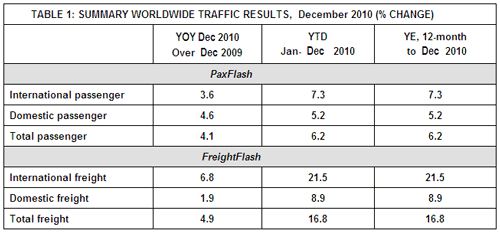Moderate airport traffic growth ends banner year
- Like
- Digg
- Del
- Tumblr
- VKontakte
- Buffer
- Love This
- Odnoklassniki
- Meneame
- Blogger
- Amazon
- Yahoo Mail
- Gmail
- AOL
- Newsvine
- HackerNews
- Evernote
- MySpace
- Mail.ru
- Viadeo
- Line
- Comments
- Yummly
- SMS
- Viber
- Telegram
- Subscribe
- Skype
- Facebook Messenger
- Kakao
- LiveJournal
- Yammer
- Edgar
- Fintel
- Mix
- Instapaper
- Copy Link
Posted: 2 February 2011 | Airports Council International (ACI) | No comments yet
December passenger traffic rose by a moderate 4 percent relative to December 2009, yet despite the slower rate, world traffic finished at just over 6 percent growth for the year…
December passenger traffic rose by a moderate 4 percent relative to December 2009, yet despite the slower rate, world traffic finished at just over 6 percent growth for the year, according to the PaxFlash sample results.
For only the second time in 2010 (April and December), in all regions traffic growth remained below the 10 percent mark (Tables1 and 2). For December, the fastest growing region was the Middle East (+8.7%) where Dubai (+11.6%), Abu Dhabi (+10.9%) and Muscat (+18.2%) delivered double digit growth.
Africa performed well, reporting growth of 7.1 percent owing to strong demand to tourism destinations in Egypt, Tanzania and South Africa. Hurghada (Egypt) surged by 23.3 percent, Durban (South Africa) increased by 11.5 percent and Dar Es Salaam (Tanzania) by 17.1 percent. Africa’s largest airport, Johannesburg, reported 6.1 percent growth.
December was the weakest month in 2010 for the Asia Pacific region, which reports 6.2 percent growth. Both of the Shanghai airports ended the year strongly with monthly growth of 30.2 percent (SHA) and 18.7 percent (PVG). Only two airports with double-digit growth were not located in India or China: Colombo increased passenger numbers by 20.2 percent while Melbourne had 11 percent more passengers. Traffic contracted at all six Japanese airports participating in the sample as domestic traffic continued its decline. The 12 percent decline at Narita airport in international passengers is in part a result of the Haneda terminal opening and new international routes there. (Tokyo Haneda has reported its international passenger numbers since the opening of the new terminal, and for this reason Haneda results were removed from the sample to avoid distortion.)
Latin America-Caribbean continues to report mixed results within its overall growth of 9.1 percent. Brazil, Peru, Colombia and Ecuador registered double digit growth, most notably in Brazil where Brasilia (+18%), Sao Paulo (+16.6%) and Rio de Janeiro (+15.3%) show no signs of a slowdown in steadily growing domestic or international traffic. On the other side of the spectrum, Mexican airports cannot shake off the effects of a faltering economy and security concerns that continue to dampen demand.
North America benefited from robust domestic demand of +3.4 percent. Austin (+14.2%), Houston (HOU, +10.9%), Fort Lauderdale (+10.3%) and New York (LGA, +10%) top the sample; however, at Chicago Midway (-0.3%), Las Vegas (-0.4%), Tampa (-2%) and Newark (-3.6%) domestic traffic was stagnant and international traffic declined.
Europe (+0.1% for the region) suffered from the exceptionally harsh winter weather that disrupted operations in Central and Western Europe, leading to a large number of cancellations particularly in domestic traffic. Frankfurt, Paris and London were among the hardest hit. Frankfurt declined 1.6 percent total, while shedding 8.3 percent domestically. Paris (CDG) was 2.2 percent down. London Heathrow was most seriously affected with a loss of 9.7 percent overall and a quarter of its domestic traffic. Other airports in the UK and Ireland also registered double digit decreases due to winter weather and knock-on effects. The weak economic environment held down the usual surge in holiday travel for Spanish and Greek airports, particularly visible in domestic traffic results. Additionally, air traffic controllers in Spain went on strike causing numerous flight cancellations.
Twelve months results, however, are positive with global passenger traffic finishing on a strong 6 percent increase for 2010. International passenger traffic rose by 7 percent, whereas domestic traffic increased by 5 percent for the year.
ACI Director of Economics Andreas Schimm says, “2010 was a banner year for air traffic generating a much quicker recovery than expected. The 6 percent growth takes the global industry well beyond pre-crisis volumes, but the recovery continues to progress in a two-paced manner between developing and mature markets. Exceptional factors such as volcanic eruption, airline cabin and ground worker strikes, severe weather and new security scares affected Europe and North America more deeply than the fast growing markets of India, China and Brazil. Nonetheless, the industry needs to remain vigilant, as setbacks to aviation business can occur unexpectedly as we have recently witnessed with the bomb incident in Moscow and political unrest in Tunisia and Egypt.”
Freight traffic: After a marked slowdown in freight growth since mid year 2010, December traffic registered a small resurgence in air freight tonnage growth owing to international shipments. These shipments regained momentum in Asia Pacific (+7.5%), Latin America (+11.5%) and Middle East (+3.4%). Although Europe (+5.4%) and North America (+8.5%) experienced a further slowdown in international freight growth, they remain on a healthy level. Freight volumes in Africa (-4.4%) declined markedly for the second month in a row.
Schimm adds, “It remains to be seen whether air freight in 2011 will be able to hold on to the volumes reached during the first half of 2010. Growth rates were exorbitant at that time so remaining in growth territory from now on, which December results suggest, would be excellent news for the global economy, shippers and airports.”















